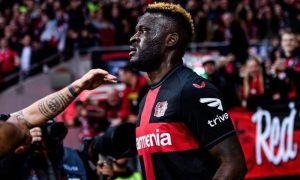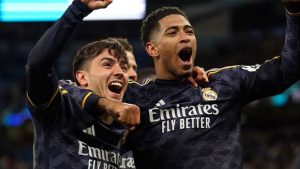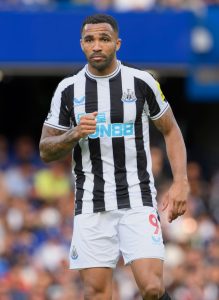Cameroon have tough World Cup group with Brazil and Serbia, even if Onana saves them – predicted line-up and stats

CAMEROON face a strong group. Their opponents in Group G will be Serbia, Brazil, and Switzerland. Serbia seems to be the most likely team to reach the Round of 16, together with Brazil.
The Africans will have to fight against the Europeans to reach the Round of 16, as Brazil is definitely expected to finish 1st in the Group. Let’s learn more about the international team of Cameroon!
Predicted Starting XI
Since taking the job mid-calendar year, manager Song has deployed many different formations with Cameroon.
Given the side’s strength in depth in the midfield department, the manager has been able to chop and change the shape depending on the opponent.
Primarily, Cameroon shift between conventional back four systems, such as 4-4-2, 4-3-3, and 4-1-4-1, as well as the 4-2-3-1, although this has been the structure least used by the Cameroonians.
GET £40 WORLD CUP BONUS WITH 888SPORT
How Cameroon could line up in Qatar
read more world cup news
Given that Cameroon will potentially be forced to drop off and defend for large parts of their games, Song will likely line his players out in a 4-4-2.
Attacking phase
Over the course of 2022 so far, Cameroon have boasted 56% of ball possession per game, on average.
During the AFCON last year, the side held the third-highest possession average in the competition at 58%, losing only to Morocco and Algeria who had higher numbers.
FREE BETS AND SIGN UP DEALS – BEST NEW CUSTOMER OFFERS
Most read in Sport
However, Cameroon’s numbers are greatly inflated due to Song’s team playing a lot worse opposition than what the Indomitable Lions should expect in Group G of the World Cup.
For instance, in Cameroon’s recent friendly against South Korea, the African giants had merely 38% of the ball and lost 2-0.
Song is quite relaxed about his players having possession of the ball. It would be far from correct for any pundit to call Cameroon a possession-oriented team.
This is because on the ball, particularly during the build-up phase, the manager is keen to play direct football.
Cameroon do like to position themselves to play out from the back, with the goalkeeper often trying to build up from the defensive field directly to the attacking zone.
Cameroon position themselves to play out of the back – as centre-backs split to accommodate the keeper’s high position
When the Cameroonians do so, the centre-backs split wide to accommodate the higher positioning of the goalkeeper while the fullbacks move up the pitch on the flanks.
The centre-back plays a long ball to the frontmen while Cameroon’s midfield support the attack
Once the ball is played long towards the frontmen, the objective for Cameroon is to win the second ball.
In the image below, the left centre-back has hit the ball directly to the centre-forward who has managed to drag the entire Algeria backline into a deeper position.
Cameroon look for direct passes into Choupo-Moting and Aboubakar
Players like Choupo-Moting and Vincent Aboubakar are excellent aerially and with their hold-up play, making direct passes an efficient option for Cameroon.
The same principle applies when Cameroon are set up in a structured positional attack around the halfway line and are attempting to break down an opponent’s defensive zone.
Again, here, we see both Cameroon’s central midfielder and centre-forward making a run in behind the Burundi backline.
HOW TO GET FREE BETS ON THE WORLD CUP
The central midfielder and forward make a run behind the defence’s line
In attack, there is nothing overly innovative or astonishing about Cameroon.
However, they do have proven, European quality among their ranks in attacking positions across the forward line and the advanced midfielders.
One of the key elements of Cameroon’s play is that it is very direct and very physical.
Defensive Phase
Cameroon are one of the highest pressing sides in Africa, certainly out of the teams from the continent that have qualified for the upcoming Qatar World Cup.
Out of possession, Song is a highly progressive coach.
The gaffer wants his side to press high up the pitch, stifling the opponent’s build-up play and attempting to win the ball in very dangerous areas where they can transition from defence to attack in an instant and try to create opportunities.
Each player is tasked with tightly marking one of the nearest passing options for the opposition.
The nearest passing options are marked by Cameroon players
Here, the players have all been assigned a man to mark when Burundi are attempting to pass out from deep.
When pressing in a high block, Cameroon are actually really effective and cause a lot of trouble for their opponents which can be seen from the following data visual.
Since AFCON in 2021, Toko Ekambi, who has been used as a winger as well as a centre-forward.
However, Song has a tendency to only order his players to press against lesser opponents as these are games where Cameroon have the best opportunity to win their individual duels against each man.
In matches against teams of greater quality, such as Algeria or Morocco, Cameroon have primarily dropped off to defend in a compact defensive block, limiting the space behind the backline.
Defensively against stronger opposition, Cameroon drop off to defend in a compact block
As can be seen from this image, Cameroon’s 4-1-4-1 defensive block is narrow between the lines.
If an opponent plays the ball inside the lines, the players must gang up to either win back possession or force a pass back outside before recouping the same shape.
Two Cameroon stars quickly close down the ball carrier
Here, the Algerian midfielder has received and turned on the ball. In an attempt to negate the ball carrier carrying the ball further, the two nearest players quickly close him down.
Transitions
Transitions are not overly important to the overall tactical set-up of Cameroon.
Defensively, there is more of a game plan or at least an idea of how to act in this phase. Unlike most teams these days, Cameroon don’t counterpress.
Counterpressing is a collective effort from numerous nearby players in a structured manager to close down the ball carrier, cutting off a counterattack at its source. Song’s men are merely looking to delay their opponent’s breakaway.
This can be through fouling or by genuinely making an excellent tackle.
Song’s Cameroon look to delay their opponent’s breakaway with a foul or tackle
In this example against Burundi, the Cameroon player tracking back shuttled the carrier out wide, closing off the possibility of the attacker playing back inside.
When attacking, the manager allows his players to be freer with their movement, emphasising plenty of ball-carrying, dribbling past opponents and running in behind.
Running with the ball and getting in behind is encouraged
Having players such as Zambo-Anguissa who is an excellent ball carrier as well as Jean Onana while Aboubakar and Toko Ekambi move beyond the opponent’s backline is instrumental to Cameroon being dangerous during attacking transitions.
Defenders
Nouhou Tolo on the left and Collins Fai on the right will be important in providing width for Cameroon. Jean-Charles Castelletto and Nicolas Nkoulou, this will be the duo in the middle of the back four, could form a decent partnership for the African nation.
Furthermore, André Onana will be vital at initiating Cameroon’s attacks.
Midfielders
Samuel Gouet has been Song’s preferred option as the ‘6’ for Cameroon over the past calendar year.
The midfielder will be instructed to make passes into the space between the lines to the forward line and advanced midfielders while also protecting the backline during transitions.
It is further forward in the middle where Cameroon possess the most quality. Jean Onana and Zambo-Anguissa are two incredibly exciting midfielders.
Attackers
In attack, Cameroon are stacked with experience, power, pace, strength, intelligence and goalscoring ability with players such as Vincent Aboubakar, Choupo-Moting and Toko Ekambi who have played at the highest level in Europe.
However, the depth from the bench will be equally important. Bryan Mbeumo and Georges-Kévin Nkoudou are interesting options too.
Key player
Cameroon have several excellent players within the squad, especially those who are applying their trade at some of Europe’s biggest clubs including André Onana at Internazionale and Choupo-Moting at Bayern Munich, and so it was extremely difficult to pinpoint which player would be absolutely key for the Rigoberto Song in Qatar.
However, Franck Zambo-Anguissa is definitely a strong name of this team.
Having failed to adapt to life in the Premier League with Fulham, the midfield general moved on loan to Villarreal and later Napoli before permanently joining the latter last summer.
Now, he is a star performer for Luciano Spalletti’s Serie A table-toppers.
Tournament Prediction
Cameroon faces a strong group alongside Brazil, Serbia and Switzerland and are certainly the underdogs from the quartet.
Read More on The Sun
Realistically, Cameroon should finish bottom of the foursome but a win and a draw against Serbia and Switzerland could be enough to see Song’s side advance.
As they’ll face Switzerland, the third force of this group, in the first game, a victory could be very important to boost morale and perhaps allow them a chance to finish 2nd behind Brazil and reach the Round of 16.
For even more detailed analysis of all 32 teams in the FIFA World Cup 2022, download your copy of the November Total Football Analysis magazine here






